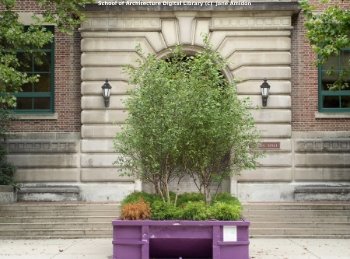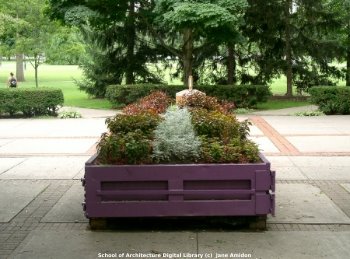
"You may not know his name," the New York Times wrote four years ago, "but you have probably enjoyed the public spaces he has created."
He is Ken Smith, "the Elvis Costello of landscape architecture."
"Perhaps," the Times continues, "you sat on an Art Deco bench and admired the Islamic geometric patterns of the paving stones at Malcolm X Plaza in Harlem or walked through the Glowing Topiary Garden he and Jim Conti, a lighting designer, installed three years ago at Liberty Plaza for the winter solstice. If you've been to Toronto, you may have walked through his idiosyncratic Village of Yorkville Park, with its 700-pound rock and miniforests and the rain curtain that freezes into icicles in winter."
Smith, we read, has a "Seussian mind," which means that he freely combines glass elevators with bamboo gardens – moving, earthless landscapes; horticultural Cubism – and he adds "glacial hummocks, grasslands, [and] honey locusts," even while opening up space for ice skating. And so on.
But what interests me here are Smith's so-called Dumpster Gardens, where you take a dumpster – or skip, if you're British – and grow a garden in it. Portable landscapes.
In 2003, Smith installed three such Dumpster Gardens at Ohio State University –




– as these photographs attest.
"Each of the three Dumpsters houses different plant life," Ohio State University's student newspaper tells us. "One contains a fragment of lawn and a second has juniper shrubbery and river birch. The third stands in front of Ohio State President Karen A. Holbrook's office with a bed of scarlet (celosia) and gray (artemisia) flowers. (...) Each of the Dumpsters is three feet deep and 20 feet long. The bottom is covered with gravel to allow for drainage and the rest is filled with planting soil."
But Smith's dumpsters are not doomed to spend the rest of their days in the empty, mausolean fate of decorating university campuses; indeed, returning to the New York Times: "Dumpsters would also be a great way to enliven traffic medians, Mr. Smith said. 'You could grow corn, or have a portable meadow of Queen Anne's lace and juniper,' he suggested."
Of course, you could also link them all together into a walled labyrinth, a postmodern hedge maze that twists and meanders through the city; you could grow hybrid flowers and Aspen trees, poisonous fungi and ergotic growths, in others, a kind of dumpsterized botanical taxonomy; you could tow gardens all over the country, even, driving every mile of the US highway system (and terrestrially out-performing Robert Smithson in the process); you could ship the things to the middle of the Atlantic Ocean where they'd be permanently anchored, forming tax havens, utopian atolls, a new Earth; or, better yet, you could skip the dumpsters outright and use enormous wicker baskets: plant amazing and weird asymmetrical gardens in each, then attach them to hot-air balloons – bulletproof, Artificially Intelligent hot-air balloons. Set them loose in the sky.
Aerobiology.

Gardens drift slowly above your head on trade winds, trailing creeper vines; a jellyfish, made of kudzu, flying through the stratosphere. New weed species auto-hybridize, evolving super-seeds, and they re-invade the earth from above. Literal new levels of biological warfare. Hugo Award-winning novels are written, documenting the vegetative horrors.
One of the balloons then crashes in the forests of Papua New Guinea and, instead of a cargo cult, you find a cult of landscapes-that-fall-out-of-the-sky.
Gardens in a space capsule. They re-enter Earth's atmosphere and crash outside London 5000 years from now. Ken Smith is there to greet it – turns out it was his idea in the first place...
In any case, Smith also has a book. More info on some of his other projects here and here and here.
No comments:
Post a Comment